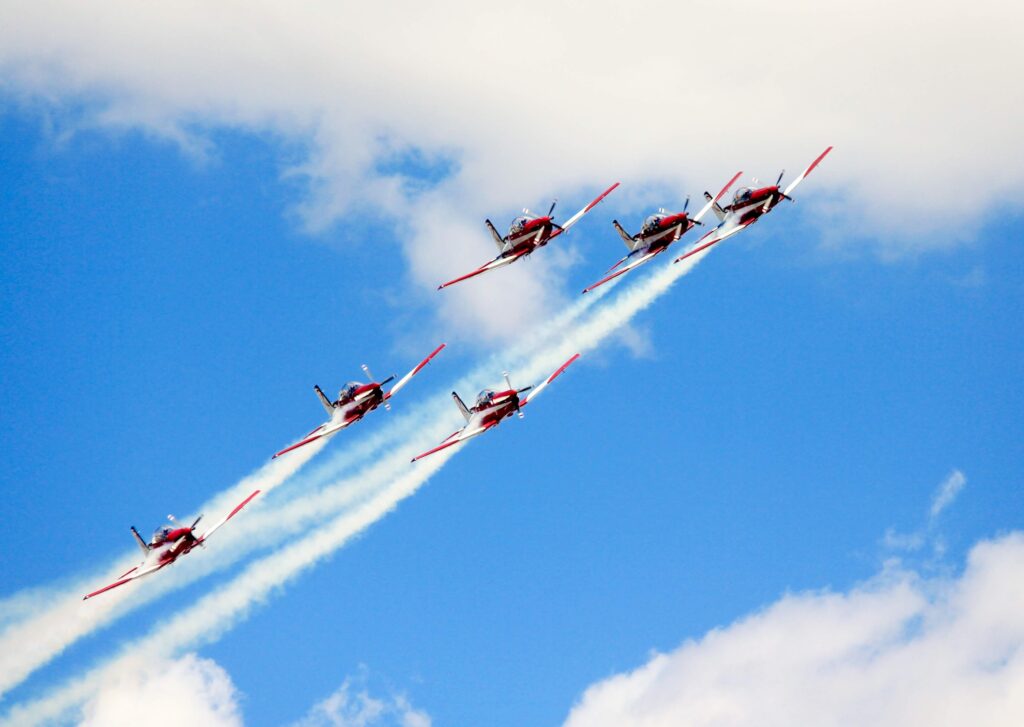Roulettes have the ability to make our heads spin. It does not come as a surprise then that the Royal Australian Air Force chose this name for its aerobatic display team. The patrol performs about 150 flight shows a year, in Australia and abroad. After years of flying, their PC-9s are to be retired, but not without a last display of their skills. Luckily, their next stop from the RAAF might be closer than you think.
The Roulettes team is part of the RAAF Central Flying School (CFS) and is based at RAAF Base East Sale in Victoria. They are not the first attempt of the CFS at creating an aerobatic team. In 1962, the school created the Red Sales, a team flying on De Havilland Vampire fighter jets. Sadly, on August 15, 1962, four pilots and two passengers, all part of the team, crashed as they were training for an RAAF Open Day Display that was to take place the next month. A year later, a new team was created, the “Telstars”, first flying on Vampire jets, then on Italian-made Aermacchi MB-326. But in April 1968, the team was disbanded after budget restriction.
It was in 1970, to celebrate the 50th anniversary of the RAAF, that the Roulettes were created. They take their name from one of their early figures called the Roulette (similar to the emblematic Carousel of the British Red Arrows). After a decade of aerobatics, five Macchis used by the team began showing signs of fatigue. In 1989, the Roulettes switched to a brand new aircraft, a turboprop this time, that the RAAF had just acquired for pilot training: the Pilatus PC-9.
After the success of the PC-7, which has through the years been adopted by 23 air forces (out of which six for their aerobatic team), Pilatus engineers envisioned an improved plane based on their best-seller.
While quite similar in design, the PC-9 shares only about 10% of the PC-7 characteristics. In all regards, it is a bigger and better performing version of its predecessor. It offers a larger canopy and an elevated seat for the passenger, facilitating the work of a flight instructor. The PC-9 is powered by a Pratt and Whitney PT6A-62 with 1,150 shaft horsepower (downrated to 950 SHP).
In 1985, Pilatus proposed both its PC-7 and PC-9 to the Australian government as an alternative to the Wamira program which was supposed to develop a training aircraft for the Royal Australian Air Force. Winning over the Embraer Tucano, Pilatus received an order of 69 PC-9A. The first two were delivered directly by Pilatus, 19 aircraft were manufactured by Pilatus and assembled by Hawker De Havilland Australia, and the remaining 48 were manufactured entirely in Australia.
The composition of the Roulettes leveled at six PC-9, plus a spare that was flown by the team’s public relations officer who provides commentary during displays. The planes were painted in bright red, white and blue, the emblematic livery of the patrol. RAAF adopted these colors for most of its PC-9 trainers, allowing an aircraft to be incorporated or taken out of the patrol to harmonize the flying hours of the fleet by simply painting a big R, symbol of the patrol, on the tail.
The Roulettes used the PC-9 for almost thirty years to show the whole world the high level of skills of the RAAF pilots. In 2005, the Australian government decided to trust Pilatus’ engineering once again and ordered 49 of their latest trainer, the PC-21. The aerobatic team is to say a last farewell to their iconic aircraft at the Australian International Airshow on March 3, 2019, at the Avalon Airport (AVV) in Victoria, Australia. But the legend does not die here!
Five of the Pilatus PC-9/A used by the Roulettes will be sold in an auction organized by Australian Frontline Machinery that will take place between February 23 and March 4, 2019. Potential buyers will be able to get a closer look at them during the Avalon Airshow. The sale will also include 22 Bell Kiowa Helicopters of the Australian Defence Force.
For more information, visit:
https://www.australianfrontlinemachinery.com.au/vehicle-types/aviation
https://www.graysonline.com/promotions/military

